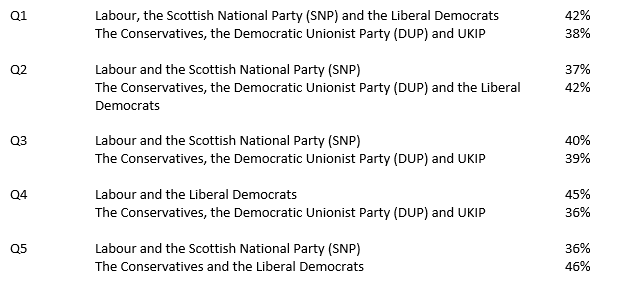What government does the public want?
What government does the public want?
Given the likely outcome ? the two big parties with 265-285 seats each, the SNP with 35-50, the Lib Dems with 20-30 and UKIP with 1-4 ? the question has naturally moved onto the various parliamentary manoeuvres that will allow a government to be formed.
This week therefore our polling measured support for the various coalition combinations or, to put it another way, the possible governments on offer. In the days of single party governments the usual ?share of the vote? polling would provide this but arguably it now needs to be asked separately.
We didn?t ask about every possible combination because with seven possible parties (Plaid Cymru excepted) we?d be looking at dozens of possible combinations even once we adjust for their likely sizes in the new parliament. Therefore the rule we used was that each coalition must contain at least one ?big? party (Labour or Conservative) and either one medium sized party (the SNP or Liberal Democrats) or two small parties (the DUP and UKIP) while taking into account things like the Lib Dems refusing to work with UKIP. In this way we feel we have covered most of the realistic combinations although we accept that this is very much a value judgement on our part.
We gave no information about which party had the most votes or seats although, as we have discussed, this could have a major impact on opinions.
This was done before Nick Clegg?s recent comments about refusing to join a Labour-SNP pact but the results show why that may have been quite an important intervention by Mr Clegg.

In Q3, the only question where the Liberal Democrats aren?t included in the calculations, the two possible blocs are neck and neck with around two fifths of the electorate supporting each. Liberal Democrat voters in this question were narrowly in favour of the Labour-SNP group (36% to 26%) but an even larger percentage answered ?don’t know? (38%).
If we add the Liberal Democrats to any of the blocs then that combination of parties starts to take a lead as we see with Q1 and Q2.
If the more polarising parties like the SNP or DUP and UKIP are removed then a combination of one of the bigger parties and the Liberal Democrats becomes the more clearly favoured choice as we see with Q4 and Q5. In each case ?big party + Lib Dems? is the choice of around 45-46% of voters.
In theory one would expect the total for each bloc to correspond to the combined total vote share of each constituent party. This was the basis for saying that the post-2010 coalition had the support of 59% of voters because 36% had voted Conservatives and 23% had voted Liberal Democrat.
But this is a fallacy. Parties don?t ?own? their voters because people vote for parties for different reasons as the Liberal Democrats discovered to their cost. When we look at the crossbreaks of these various combinations we find that although most voters back any bloc that contains their party, there are some important pockets of doubt.
Take Q1 for example. Liberal Democrats split 55% to 18% in favour of the Labour-SNP-Lib Dem bloc vs. the Conservative-DUP-UKIP bloc but when they are moved to replace UKIP on the right the margin is slightly smaller, 50% support the Conservative-DUP-Lib Dem bloc vs. 29% supporting Labour and the SNP on their own.
Around 80-85% of Labour voters support whichever bloc contains Labour but Conservatives are more varied:
93% would support a Conservative-Lib Dem bloc against a Labour-SNP bloc but when asked to choose between a Conservative-DUP-UKIP bloc and a Labour-Lib Dem one that figure drops to 75%. Even if one adds the SNP to the Labour-Lib Dem bloc the percentage of Conservatives supporting ?their? bloc still only rises to 77%.
The biggest party-sorting of all, as mentioned, took place shortly after the 2010 coalition was formed when a huge section of anti-Tory Liberal Democrats defected to the Labour party and elsewhere. It should therefore be unsurprising that 2010 Lib Dem voters as a group tend to lean towards the Labour bloc. While current Lib Dems prefer a Conservative-Lib Dem government to a Labour-SNP one by 62% to 24%, 2010 Lib Dems are evenly split, 41% vs. 42%. Perhaps unsurprisingly the government that 69% of 2010 Lib Dem voters would support is a Labour-Lib Dem deal against 13% for a Conservative-DUP-UKIP deal.
We already knew that government formation and interpreting the ?will of the people? would be more complicated in an era of multi-party government than for single-party government. What these figures suggest is that it is, somehow, even more complicated than that. Parties don?t own their voters and supporters of each party are not monolithic blocs. Even among UKIP voters, who one would expect to be lock-step behind a government that contained their party, 10% would support a Labour-SNP-Lib Dem deal over a Conservative-DUP-UKIP one.
Party leaders contemplating post-election deals are facing a far from simple decision.




